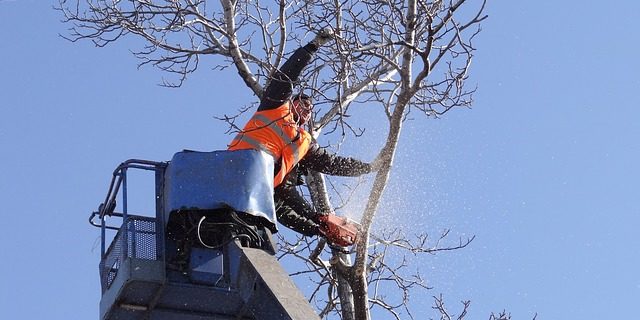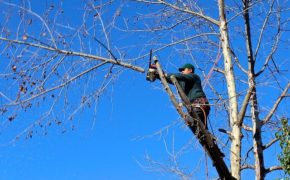
Get a quick no obligation quote It’s free and will only take a jiffy!
The Law on Cutting Down Trees: All You Need to Know
When it comes to cutting down trees, careful consideration is vital. Whilst it may be the only option, perhaps for safety reasons, the process of felling a tree is subject to a variety of legislation. Whether you are looking to cut down or protect a tree, the following advice will help you understand the law.
The law on felling trees
If you are looking for information on the legal side of felling trees, you can obtain advice from your local council or, in England, the Forestry Commission.
It is vital to remember that it is against the law to fell or cut back a tree if it will affect nesting birds.
Felling trees in your garden
If you are the homeowner, then you won’t need to obtain permission to fell a tree that is growing within the boundary of your property, unless it is subject to a Tree Preservation Order (TPO) or is in a Conservation Area.
If you live in private rented accommodation, then you must obtain permission from the landlord if you wish to make any changes to trees on the land, including pruning or felling.
If whilst carrying out work on a tree in your garden, you cause injury or damage to a neighbour or their property, then you will be liable.
If a tree is growing in your garden but branches are overhanging neighbouring property, then the neighbour has a right to cut back the branches. The branches do however remain your property, and they should offer them to you.
When a felling licence is required
For trees growing outside of private gardens to be felled, a felling licence may be required. If the tree or group of trees to be felled amount to five or more cubic metres of timber by volume, then it will be an offence to fell without a licence. The government’s Timber Volume Calculator can help you work out the volume of timber you may wish to fell.
You will need to apply to the Forestry Commission for the licence, which will discuss conditions before issuing it. You may find that you are required to replant the area and maintain the replanted trees for a set period of time.
What are the alternatives to felling trees?
It is vital to consider that the felling of any tree will impact upon people and wildlife. It should always be a last resort.
If a tree is posing a danger to safety, perhaps because it is storm damaged, diseased or is growing in a hazardous location, then felling will usually be the most appropriate course of action. But even where trees are thought to be causing real issues, it is always worth looking at alternative courses of action. Pruning or pollarding for example can effectively remove hazardous branches and reduce the impact of a tree without doing away with it altogether.
A qualified tree surgeon will help you ascertain the best course of action, and will be able to provide expert guidance on how best to manage trees that are causing issues.
What to do following the felling of a tree
Once a tree has been felled, you will need to follow the conditions of the licence.
To compensate for the lost tree, the Woodland Trust recommends replanting at a ratio of at least 3:1, or whatever is set out in the felling licence conditions.
Where you have permission to cut down a tree with a TPO on it, that tree must be replaced. If the issue that led to needing to fell the tree was that it was too big or growing too close to property, then be sure to remedy those issues when replanting by opting for a smaller growing species of tree, and planting further away from the property.
How to protect a tree from felling
If there is a tree you believe to be at risk from felling and you wish to protect it, you can apply for a TPO. This is a written order from the local planning authority which is designed to protect individual trees, or entire areas of woodland. The aim is to protect trees that offer value to the public by preventing them being deliberately damaged or destroyed.
Once a tree has a TPO on it, it cannot be pruned or cut down without permission. If you feel that the risk to the tree is looming, you can ask for an emergency TPO to be applied which will prevent any work being carried out whilst the council looks into the matter further.
If a tree is in a Conservation Area, then it will have protection and will need permission before being cut down. TPOs can also be applied to trees in Conservation Areas.
The only time tree work can proceed in a Conservation Area without council permission is when it involves cutting down, lopping, topping or uprooting a tree that has a diameter less than 75mm, or cutting down or uprooting a tree with a diameter less than 100mm so as to improve the growth of another tree.
Penalties for felling trees outside of the law
It is an offence to cut down, uproot or wilfully destroy any tree that is subject to a TPO, in a Conservation Area or over five cubic metres in volume.
Anyone who breaches the rules may be fined up to £20,000, prosecuted for felling without a licence and served a notice to replace any protected trees that have been destroyed. Serious offences may be subject to unlimited fines.
If you suspect that a tree has been felled illegally, you should contact your local planning authority, or the Forestry Commission.
Tree knowhow from TH Trees Ltd
If you are unsure what to do about a tree on your land that is causing issues, or would like to fell a tree but are keen to ensure you do so within the law, contact TH Trees Ltd.
Our qualified tree surgeons will provide all the guidance you need to keep you on the right side of the law. We will also provide you with viable alternatives to tree felling wherever possible.
Had a fallen tree in the early hours of Monday morning, called for quote and the team had it cleared on the same day. Really good communication when the lads were onsite and did a great job. Lots of pride in their work shown with the thorough clear up. Would thoroughly recommend.
Thank you Stuart for your kind review. We were glad to be able to help you with your fallen tree. If there's anything else you need in the future, please don't hesitate to get in touch.








